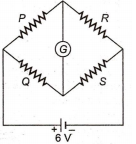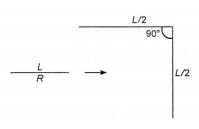 Multiple Choice Questions
Multiple Choice QuestionsIn the Wheatstone's network given, P = 10Ω, Q = 20Ω, R =15Ω, S = 30Ω, the current passing through the battery (of negligible internal resistance) is

0.36 A
zero
0.18 A
0.72 A
A.
0.36 A
The balanced condition for Wheatstone's bridge is
As it's a balanced Wheatstone bridge, no current flows through the galvanometer. Now, P and R are in series, so resistance
R1 = P + R
= 10 + 15 = 25Ω
Similarly, Q and S are in series, so resistance
R2 = Q + S
= 20 + 30 = 50Ω
Net resistance of the network as R1and R2 are in parallel
A wire of length L has resistance R. It is bent at mid-point such that the two halves make an angle 90° with each other. The new resistance would be.

R
R
N identical cells, each of emf E, are connected in parallel. The emf of the combination is
NE
E
N2E
E/N
Kirchhoff's law of junction, I = 0, is based on :
conservation of energy
conservation of charge
conservation of energy as well as charge
conservation of momentum
If the percentage change in current through a resistor is 1%, then the change in power through it would be:
1 %
2 %
1.7 %
0.5 %
3 identical bulbs are connected in series and these together dissipate a power P. If now the bulbs are connected in parallel, then the power dissipated will be:
P/3
3P
9P
P/9
What is the drift velocity of electrons if the current flowing through a copper wire of 1 mm diameter is 1.1 A. Assume that each atom of copper contributes one electron : (Given: density of Cu = 9 g/cm3 and atomic weight of Cu = 63)
0.3 mm/s
0.5 mm/s
0.1 mm/s
0.2 mm/s
An electrical cable of copper has just one wire of radius 9 mm. Its resistance is 5Ω. The single wire of the cable is replaced by 6 different well-insulated copper wires each of radius 3 mm. The total resistance of the cable will now be equal to:
270 Ω
90 Ω
45 Ω
7.5 Ω
